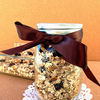Homemade gifts are the best way to show loved ones just how much you care during the holidays. In fact, anything homemade sure does have a special ring to it: homemade cookies, breads, and pasta. Nothing can beat my dad's homemade meatballs. This goes for all things homemade beyond food. Ever since the first time I picked up a pen, my mom has insisted on me creating a homemade card for birthdays, Christmas, and other special occasions. (She finally stopped asking me to pose in her Christmas card...so this is the least I could do...baby steps). No gift necessary, just a card that I made. While this makes my life a lot easier, it really does contain sentimental value.
The Recipe Redux's November theme was "Adding merriment to mixes." My obsession with breakfast foods aided in my inspiration to create a homemade muesli mix in a jar. Whole food ingredients, like whole grains, nuts, seeds, and dried fruit are packed into one merry jar. This gift isn't only from the heart, but provides heart-healthy benefits to those you care most deeply for.
Ingredients:
3 cups hot multigrain cereal (100% Whole Grain), dry
2/3 cups walnuts, chopped
3/4 cups raisins or dried fruit
2 tbsp hemp seed
2 tbsp coconut oil
1 1/2 tbsp flax meal
1 tbsp sugar
1 tsp cinnamon
1/2 tsp salt
1/2 tsp nutmeg
Note: In this muesli mix, I used a a hot multigrain cereal mix which contains oats, barley, and rye. Old fashioned oats can be used entirely in this recipe or you can experiment with other whole grains as well. Any type of dried fruit will work equally as well for this recipe.
Directions for Toasted Muesli:
1. Preheat oven to 350 degrees.
2. Combine all dry ingredients in a large bowl - cereal, nuts, seeds, sugar, and spices. Mix.
3. Add coconut oil and stir well to coat the dry ingredients.
4. Spoon the muesli onto a rimmed baking sheet. Bake for 30-35 minutes.
5. Add dried fruit to the muesli and serve over yogurt or milk.
Yield: 2 Jars
Serving Size: 1/4 cup
Happy Holidays!
As the first and only recipe challenge founded by registered dietitians, The Recipe ReDux aims to inspire the food lover in every healthy eater and inspire the healthy eater in every food lover. Thank you for visiting. We hope you enjoy!
(Please note that this is a closed link-up for Recipe ReDux posts only. Any links added to this collection for non-ReDux posts will be deleted.)
| |
Link tool by inlinkz.com







.JPG)
.jpg)
